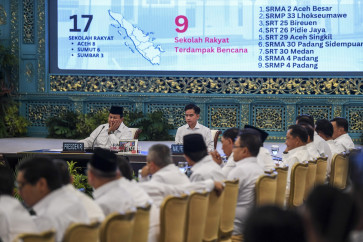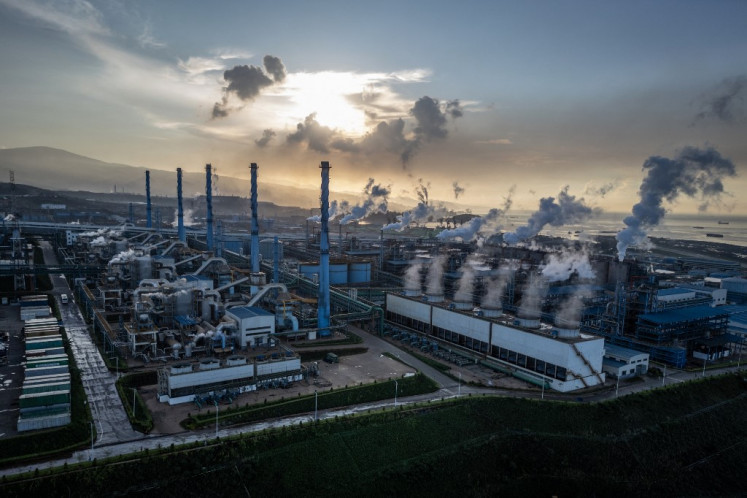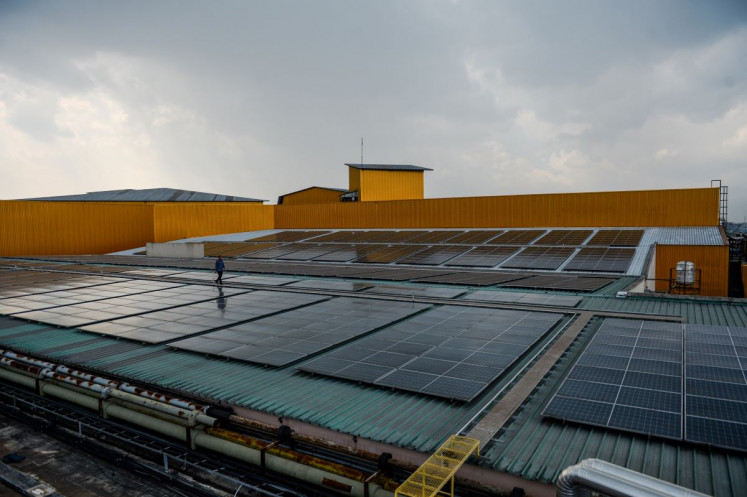Popular Reads
Top Results
Can't find what you're looking for?
View all search resultsPopular Reads
Top Results
Can't find what you're looking for?
View all search resultsTaking advantage of 'temporary' market turmoil
Free fall: Traders, some in medical masks, work on the floor of the New York Stock Exchange (NYSE) in New York City, the United States
Change text size
Gift Premium Articles
to Anyone
F
ree fall: Traders, some in medical masks, work on the floor of the New York Stock Exchange (NYSE) in New York City, the United States. The Dow fell over 500 points on March 20 as investors continued to show concerns over COVID-19. (Spencer Platt/Getty Images/AFP)
The stock market has declined by more than 30 percent year-to-date, while the bond market has erased its entire capital gain of 2019.
It is indeed a challenging time for asset managers in the capital market, both those who work as professional portfolio managers at institutions and individuals who manage their personal or family’s portfolio.
Now we are witnessing the highest year-to-date price correction since 2008. The previous significant year-to-date correction was in 2015 when the stock market declined by almost 20 percent. The bond market that outperformed strongly in 2019, marked by the declining 10-year government bond yield from 8 percent at the end of 2018 to 7 percent at the end of 2019, has had to accept a yield increase from a low of 6.5 percent in February to over 8 percent today.
The recent sell-off in the global and Indonesian capital markets, however, is more of a price risk rather than a fundamental or valuation risk. Although the main push of the market correction, which is the new coronavirus, will affect the business fundamentals of companies, it should be temporary. As for valuation, the Indonesian stock market was trading at a discount even prior to the correction.
Once the new coronavirus stops spreading, companies with a strong business model, a large competitive advantage and low leverage will survive and recover well, and so will the prices of their securities.
The question is, how long is “temporary”? The good news is there is no new coronavirus case in China, but the outbreak outside China has just begun. So, it is safer for investors to look beyond 2020 and ask themselves whether the business of companies in the portfolio will survive and recover then. Will the companies still perform well in the next 10 or 20 years and after facing another crisis in the future? If that is the case, investors should take advantage of the current discounted valuations and purchase those securities.
The consideration above is the main duty of a portfolio manager to avoid permanent damage to his/her portfolio value. To avoid permanent damage, the portfolio manager must manage the main investment risks that stem from poor business fundamentals and overvaluation. Price fluctuation is also a risk but may not cause permanent damage for investors if the two former risks are properly managed.
Until the market recovers, the fund manager should keep investing in securities with sound business fundamentals at discounted valuations. Maintaining enough liquidity at all times is essential to take advantage of purchasing at a discount and paying redemption without disturbing the portfolio and without the need for leverage.
Currently, security prices are generally low. In today’s market, you should be able to find plenty of investment opportunities. Rarely are good quality names traded at below 1 or 2 historical standard deviations of their valuation metrics and cornered to provide outstanding dividend yields. Dividend yields of LQ45 and IDX30 indexes have gone up to above 4 percent, compared to the normal 2.5 percent. Some good companies offer dividend yields above 5 percent, even up to 20 percent.
The 10-year government bond is trading back above 8 percent with a spread over United States Treasury yields of more than 700 basis points, which compares to the normal 500 basis points.
True, the fiscal deficit of the government will widen, probably to around 3 percent, but it still seems manageable for the Finance Ministry. Furthermore, Bank Indonesia seems to support the modern monetary theory by consistently purchasing large amounts of government bonds, which is essential to financing the fiscal deficit while at the same time offsetting the capital outflow, which has reached US$4 billion year-to-date. While it may push up inflation, it is not worrying yet, considering the low inflation rate at the moment.
To seize investment opportunities in the current turmoil market, investors should opt for gradual execution, assuming the bear market could persist until the end of June. The gradual execution will open a possibility of a better average cost of investment and, thus, a better return in the longer term. Both stock and bond valuations are very appealing. A combination of an index fund and ETF bond could also be considered, especially for those with moderate tolerance to price fluctuation.
But if you are in it for the long run, you will find that current stock valuations are more compelling than bond prices. The stock market’s price-to-earnings ratio of 12.5 times translates to an earning yield of 8 percent for the next 12 months. Afterward, the investor can enjoy higher yields from earnings growth in the long run. At the same time, the 10-year government bond offers 8 percent (or 6.8 percent after 15 percent tax) fixed yield annually for the next 10 years.
However, for those investing for the medium term, bonds are a good option considering they still offer returns of more than 3 or 4 percentage points above the inflation rate. Investors can still increase their real wealth by investing in bonds.
Last but not least, every investor should avoid shortsightedness due to market fluctuation, which may discourage him or her from investing in a period of undervaluation and fully invest during overvalue periods, contrary to the suggestion in this article.
______
Head of investment at Avrist Asset Management. The views expressed are his own.










